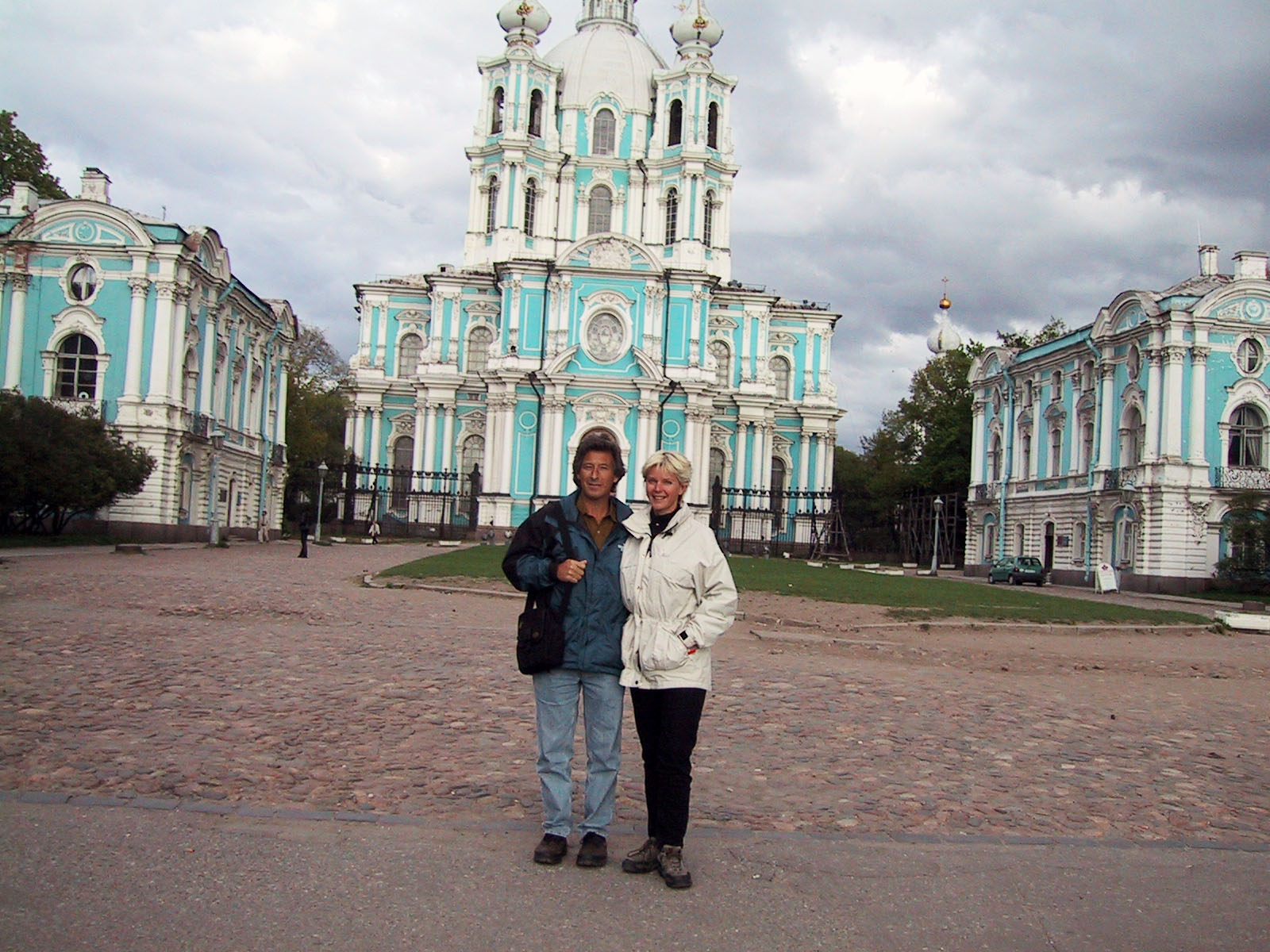 May 10, 2001
May 10, 2001
When we got our visas for our visit to Russia, we were told it would be a good idea to create a manifest of everything in our luggage, we carry computers, cameras and other electronic equipment that could be very popular to Russians these day. There could be a thorough inspection of our possessions both in and out of the country. However, we we did arrive to the customs desk it was all pretty quick and painless. Maybe they were in a hurry that day, maybe because we were so tanned out from being in Indonesia for three weeks they discounted us as simple tourists. We did look strange next to the mozzarella white skin of the Russians just coming out of winter hibernation.
We arranged with the agent to help us with our hotel arrangements and provide a car a the airport. You need to have a hotel voucher (proof of visit) in order to get a visa to enter Russia. The voucher is free unless you cancel the reservation. Then it gets very expensive.
Our ride to the hotel was in an old van with a 30 liter jug of gasoline in the front seat. Everything is expensive in Russia and the driver probably found a black market gas source. I could’t tell if the tank under the van was damaged or if the interior tank was a second, emergency tank. The driver was nice but spoke no English and so there was a lot of pointing. At any rate, by the time we got to the hotel we were pretty dizzy from the fumes.
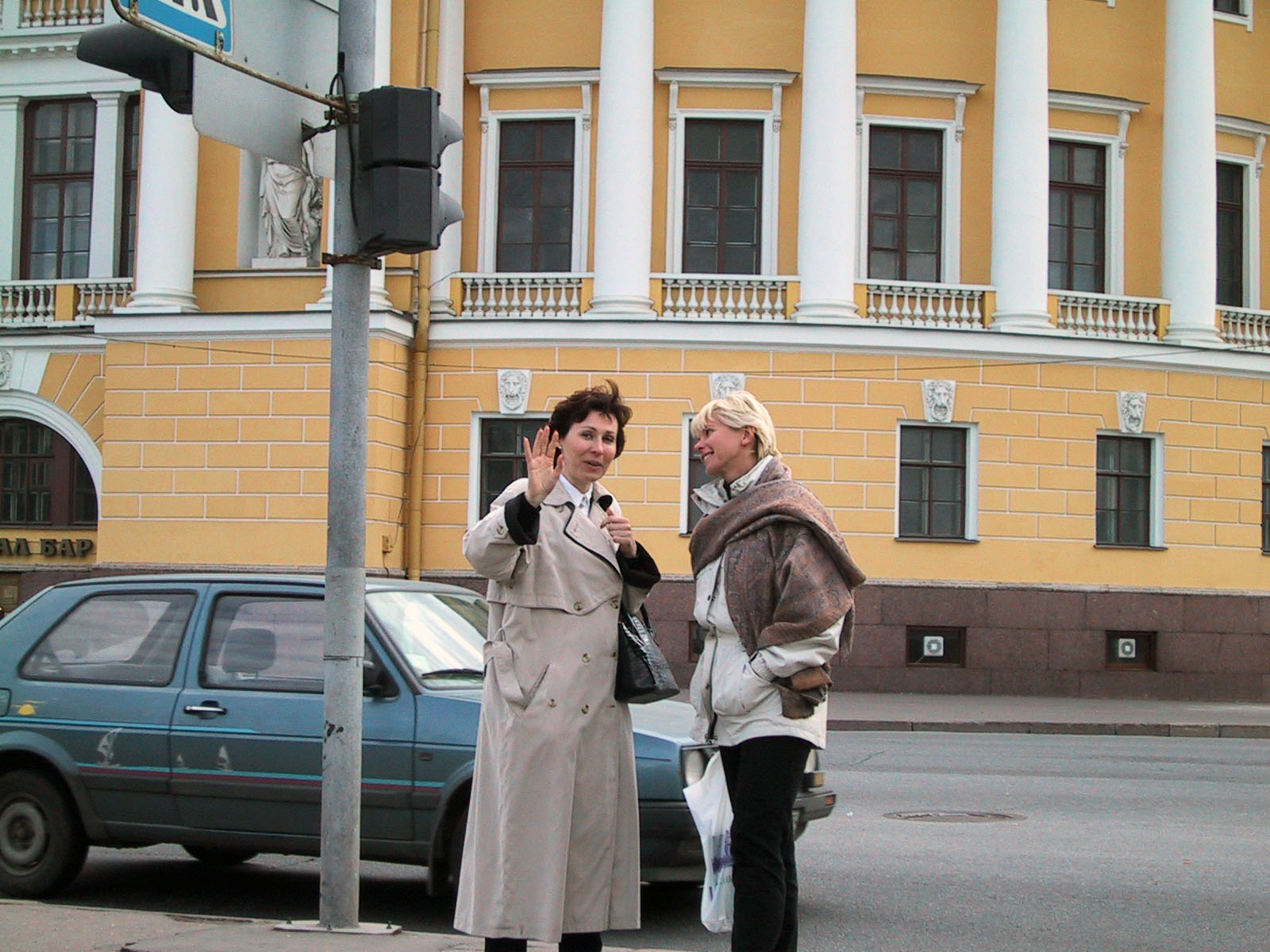 The Grand Hotel in St Petersburg is grand and beautiful and very expensive. The russian currency (roubles) is used as a guideline but the hotel prefers to charge in “units”. A unit is tied to whatever currency they like on any particular day. In today’s exchange, 1 unit = 1 US Dollar.
The Grand Hotel in St Petersburg is grand and beautiful and very expensive. The russian currency (roubles) is used as a guideline but the hotel prefers to charge in “units”. A unit is tied to whatever currency they like on any particular day. In today’s exchange, 1 unit = 1 US Dollar.
Our guide, Alla Yuskovets, is bright, attractive, highly educated, extrememly well mannered and speaks perfect european english. Sasha Alexander is our driver, speaks no english but we manage to amuse each other by butchering words of both our languages.
On our first tour day we visited the Peter and Paul Fortress along the Neva River. The fort was inaugurated by Peter the Great on May 26, 1703, which also became the birthdate of the city of St Petersburg. He built the fortress as protection against the invading Swedes, but he defeated the Swedish onslaught long before the fortress was completed. In the center of the Fortress is the the Peter and Paul Cathedral, the burial place of the Czars from Peter the Great to Alexander III. We arrived after they had just added another place to house the remains of Nicholas III and his family who were brutally killed at the start of the Russian Revolution.
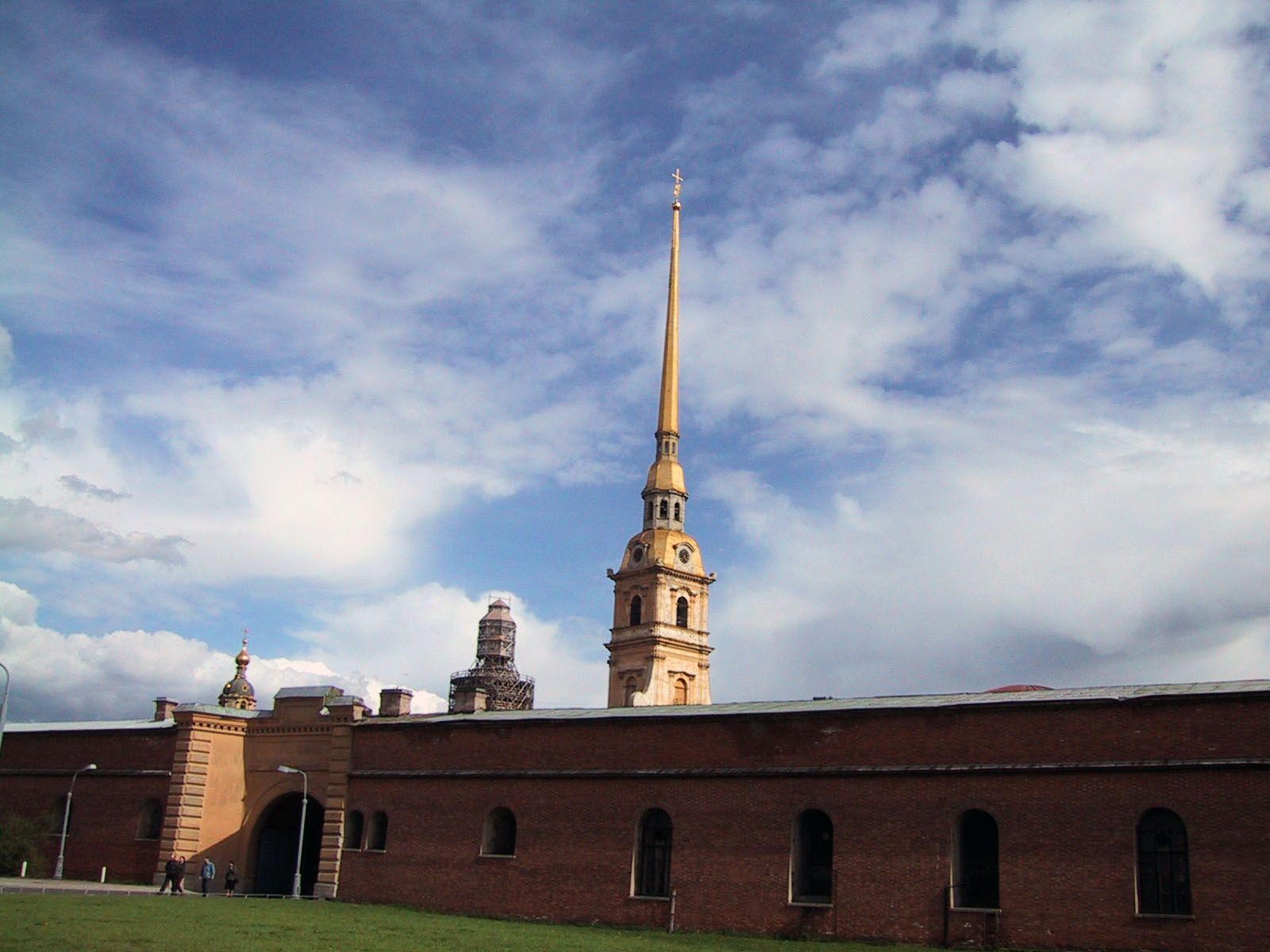 The golden spire in the center of the fortress, at 404 ft tall, is the tallest building in the city. Peter the Great broke the backs of the Russians to build his city over unstable marshlands and small islands. There are over 300 bridges connecting them all together and all of the foundations needed to be built underwater. Many people died. Unfortunately, the site of the city might not have been the best possible location. The land was marsh and the Neva river was prone to flooding. Three months after the city was concecrated, the Neva flooded and almost washed away the fort. There have been 270 major floods since.
The golden spire in the center of the fortress, at 404 ft tall, is the tallest building in the city. Peter the Great broke the backs of the Russians to build his city over unstable marshlands and small islands. There are over 300 bridges connecting them all together and all of the foundations needed to be built underwater. Many people died. Unfortunately, the site of the city might not have been the best possible location. The land was marsh and the Neva river was prone to flooding. Three months after the city was concecrated, the Neva flooded and almost washed away the fort. There have been 270 major floods since.
On November 19 1824, the river rose over13 ft above the floodline. Over 500 people were drowned and over 450 houses were destroyed. In 1924 the river rose over 12 ft over the floodline and in some areas of the city the water reached a height of 8 ft.. Many of the ships in the port were washed ashore. Additions to the river walls have helped to protect the city from flood disaster since the 1924 flood. So far so good..
The Soviet era might be over, but there are signs of the Revolution everywhere. Here in St Petersburg, the statues were left as reverence to the past, even though everyone ppears to be very happy that Soviet Russia has come to an end.
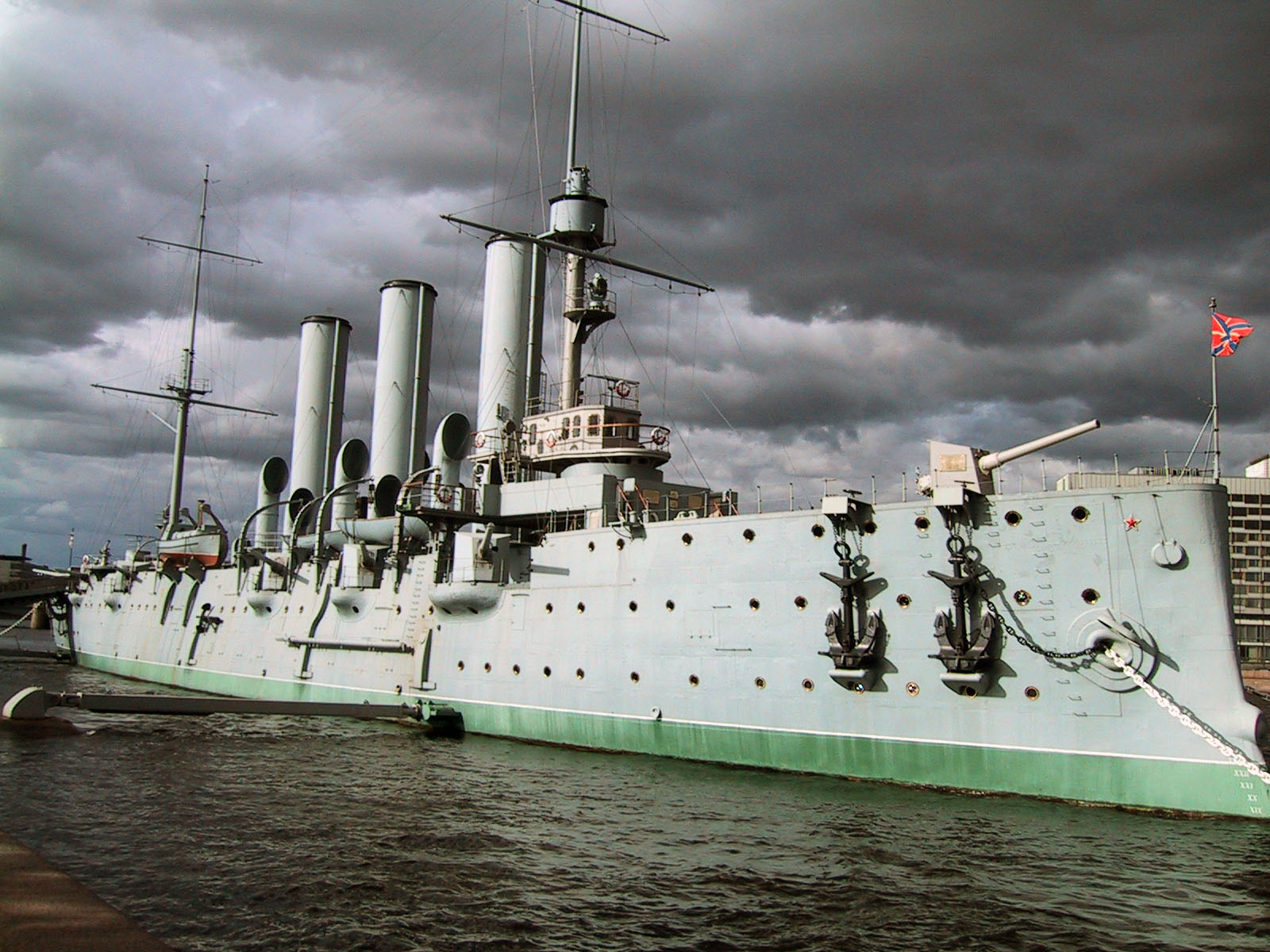
The old 1903 war ship, “Aurora” still sits in the harbour. It was the shot that rang from her guns that signaled the start of the Bolshevik Revolution on October 25th 1917. It might have been a blank shot, but the results were fully loaded as the rebels stormed the Winter Palace.
The city is full of opulent palaces and amazing wealth. One can understand why the people were so pissed off at the royals. It’s one thing to be rich but don’t rub it in the faces of the less fortunate. We always thought that the USSR was concrete and steel. Boy were we wrong. So much for US propaganda.
That night we went to the hotel restaurant, the Caviar bar to be exact. We thought we’d just have a light meal of some authentic russian caviar. The caviar wagon had 4 different types of roe; black beluga, gray sevruga, yellow osetra, golden imperial. Each terrine had at least 2 lbs of caviar. We ordered 2 portions of the beluga and the waitress gave us each about a soupspoon full. We really didn’t really eat very much. Two spoonfuls of caviar and a few appetizers. The bill was 135 units ($135). It’s an expensive city.
May 11, 2001
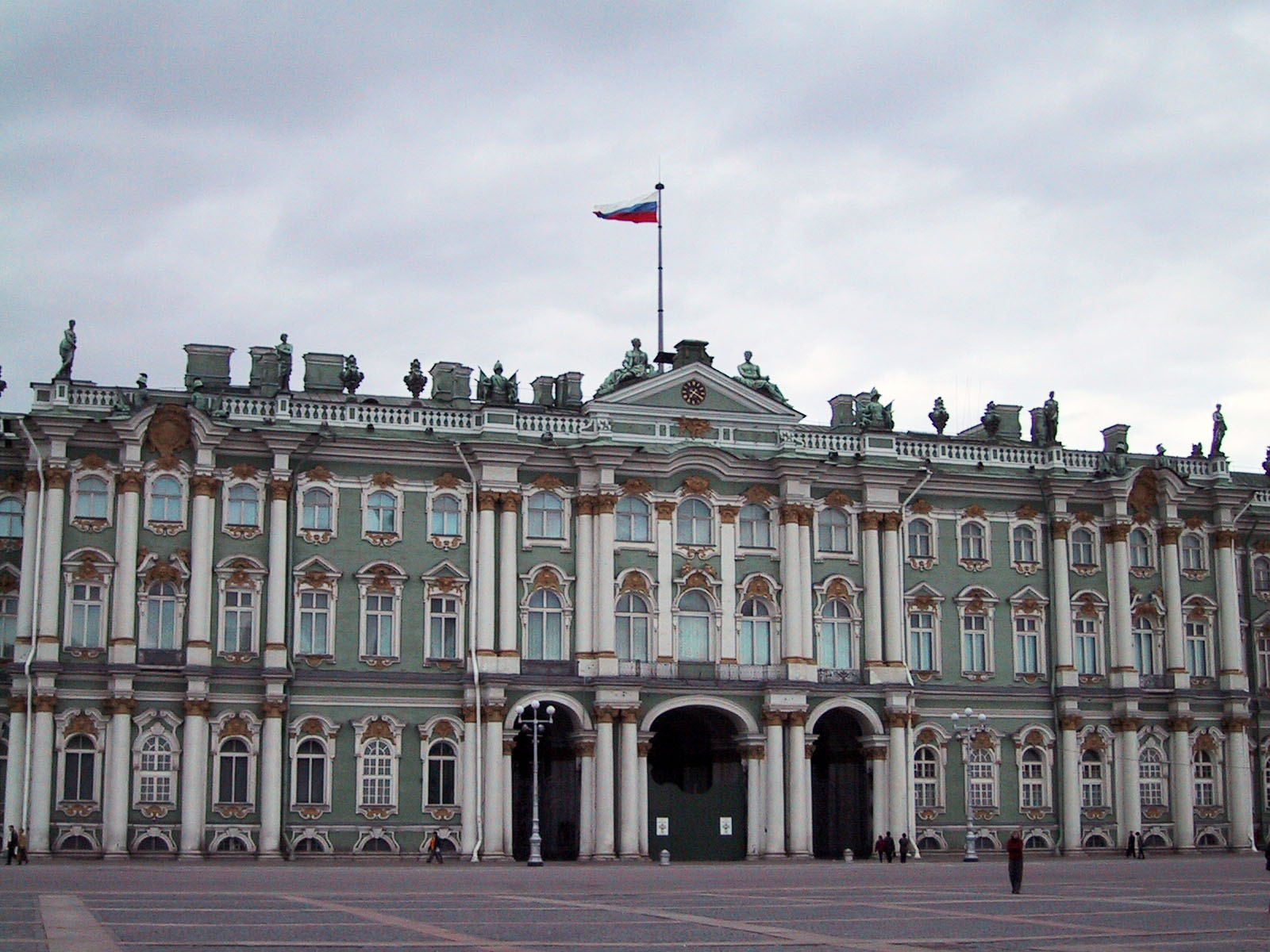 There are concrete scars of soviet style architecture but for the most part, the city remains as it was in the 1800. By 1880 it was regarded as one of the most beautiful cities int he world. You can still see much of that, even though the beauty is covered with a very thick layer of dirt and grunge. However, a restoration is in progress. The golden domes are getting polished, the churches and palaces are getting restored to their original opulence, the sidewalks are being dug up and replaced and it is very difficult to walk through all the construction zones. But in 2003, the city will celebrate the tri-centenial and everything should be just as beautiful as it was in 1917 before the revolution. or at least a lot better than it looks now.
There are concrete scars of soviet style architecture but for the most part, the city remains as it was in the 1800. By 1880 it was regarded as one of the most beautiful cities int he world. You can still see much of that, even though the beauty is covered with a very thick layer of dirt and grunge. However, a restoration is in progress. The golden domes are getting polished, the churches and palaces are getting restored to their original opulence, the sidewalks are being dug up and replaced and it is very difficult to walk through all the construction zones. But in 2003, the city will celebrate the tri-centenial and everything should be just as beautiful as it was in 1917 before the revolution. or at least a lot better than it looks now.
We have done so much here in only a few days. Our guide, Alla Yuskovets has an amazing knowledge of Russian history. She lives in St Peterburg with her husband and 17 year old daughter. Her husband is retired from the military and now works int he construction business, which seems to be everywhere.
In our 2 days here, we have taken a tour around the city, we spent most of day at the Winter Palace. This is home of the Czars and the wonderful Hermitage museum that boast of over 3 million art pieces. We must have seen at least a few thousand including Rembrant, Leonardo Da Vinci, Michaelangelo, Jan Steen, Matisse, Picasso, Soutine, Renoir and so many others. I kind of glazed over in the pottery rooms. You would have to walk 15 miles to see all 322 galleries. I have no idea how many we entered and came out from.
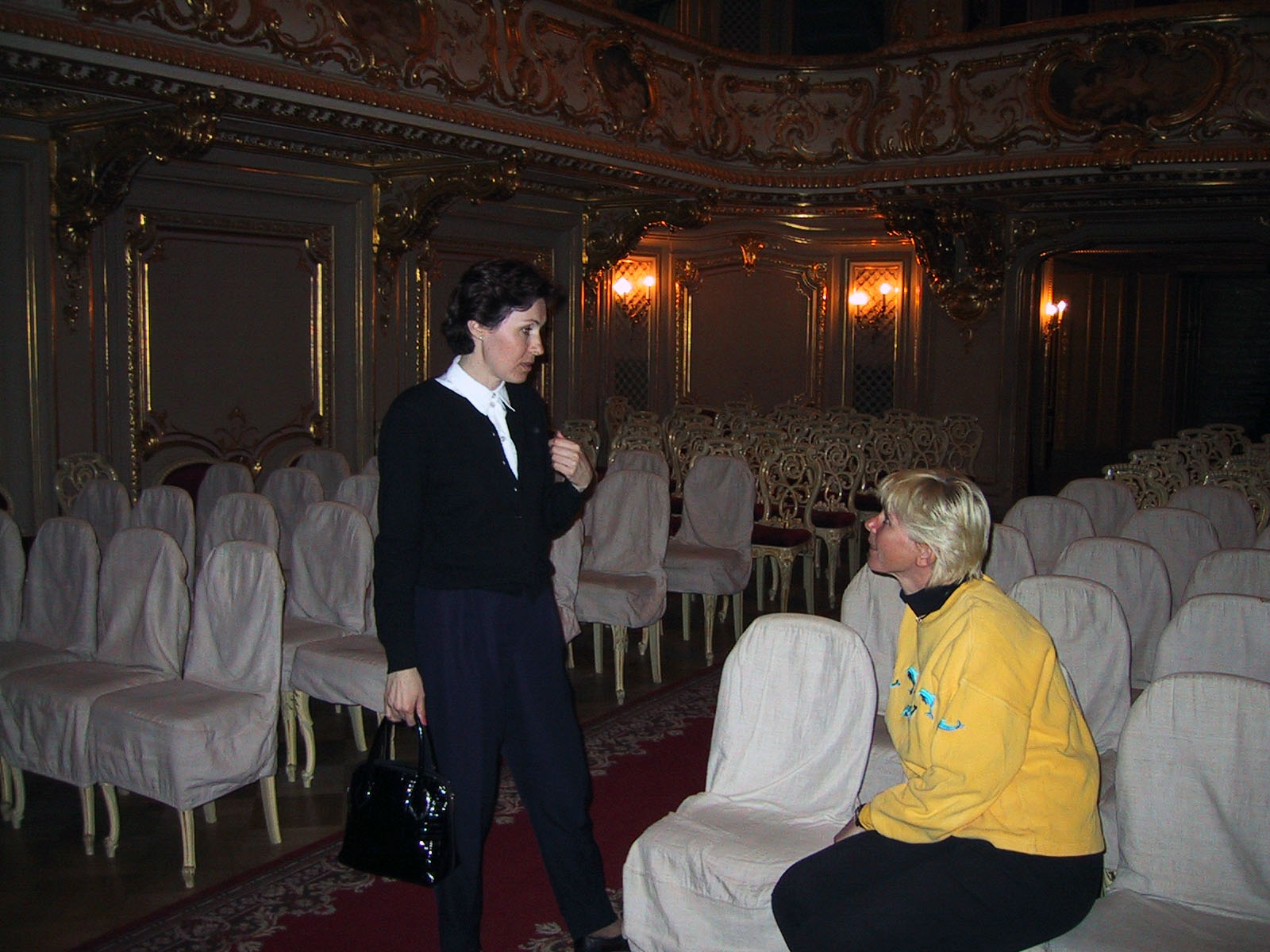 After the Hermitage, Alla took us to the Yusupov Palace. The Yusupovs were the wealthiest family in Russia, next to the royal Romonoff family. Their palace was once THE place of the most wonderful parties and balls in St Petersburg. It is now being restored to it’s original beauty and is once again used for parties, balls and other entertaining functions. The house has come alive again. One of the more curious parts of the Yusupov tour was the basement room where Felix Yusupov and three of his friends killed Rasputin. The curators of the palace had set up a reinacment of the crime complete with wax figures of the players. It was all pretty spooky. As the story goes, Prince Felix Yusupov and some of his friends invited Rasputin to the Palace and fed him cakes and red wine laced with large amounts of cyanide. However, even though it was enough to kill 10 men, the poison had no affect on the Mad Monk. Realizing they had to go to plan B, Felix left the room and came back with a gun and shot Rasputin in the back. Rasputin fell over. They thought the deed was done and decided to leave the body and go out to a bar. But it was really cold and Felix forgot his coat. He went back to where he left it, at the scene of the crime, and ccording to the legend, as he entered the room, Rasputin got to his feet, grabbed him and whispered into his ear “you’re a very bad boy”. Then he flung Felix across the room and made an escape. But before he could escape to freedom the other conspirators saw him and fired shots. They hit him another 3 times in the back. He fell over for a moment but got back up and attacked the conspirators. This time they clubbed him into submission (although I’m not sure what they used as a club), wrapped him in a sheet and threw him into the icy Neva River. Three days later the poisoned, shot and beaten body of Rasputin was recovered from the river. The autopsy cited the death from hypothermia. He appeared to have struggled inside of the sheet, trying to loosen the bindings and set himself free. The Empress Alexandra buried Rasputin’s body in the grounds of the summer Palace at Tsarskoye Selo, but after the February Revolution, a group of workers from Saint Petersburg uncovered Rasputin’s body, carried it into a nearby wood and burned it.
After the Hermitage, Alla took us to the Yusupov Palace. The Yusupovs were the wealthiest family in Russia, next to the royal Romonoff family. Their palace was once THE place of the most wonderful parties and balls in St Petersburg. It is now being restored to it’s original beauty and is once again used for parties, balls and other entertaining functions. The house has come alive again. One of the more curious parts of the Yusupov tour was the basement room where Felix Yusupov and three of his friends killed Rasputin. The curators of the palace had set up a reinacment of the crime complete with wax figures of the players. It was all pretty spooky. As the story goes, Prince Felix Yusupov and some of his friends invited Rasputin to the Palace and fed him cakes and red wine laced with large amounts of cyanide. However, even though it was enough to kill 10 men, the poison had no affect on the Mad Monk. Realizing they had to go to plan B, Felix left the room and came back with a gun and shot Rasputin in the back. Rasputin fell over. They thought the deed was done and decided to leave the body and go out to a bar. But it was really cold and Felix forgot his coat. He went back to where he left it, at the scene of the crime, and ccording to the legend, as he entered the room, Rasputin got to his feet, grabbed him and whispered into his ear “you’re a very bad boy”. Then he flung Felix across the room and made an escape. But before he could escape to freedom the other conspirators saw him and fired shots. They hit him another 3 times in the back. He fell over for a moment but got back up and attacked the conspirators. This time they clubbed him into submission (although I’m not sure what they used as a club), wrapped him in a sheet and threw him into the icy Neva River. Three days later the poisoned, shot and beaten body of Rasputin was recovered from the river. The autopsy cited the death from hypothermia. He appeared to have struggled inside of the sheet, trying to loosen the bindings and set himself free. The Empress Alexandra buried Rasputin’s body in the grounds of the summer Palace at Tsarskoye Selo, but after the February Revolution, a group of workers from Saint Petersburg uncovered Rasputin’s body, carried it into a nearby wood and burned it.
This is the legend, however there are almost as many holes in the story as there were supposed to be in Rasputin’s body. During interrogations, Felix Yusupov gave many versions of the tale and none of them were the same. The autopsy report also showed no signs of any poison in his stomach. There were also reports that Rasputin had a knife wound. There is another version of the murder that has Raspuin visiting his family in Siberia where he was stabbed in the gut by Khionia Guseva, a reformed prostitute and onetime disciple of Rasputin.
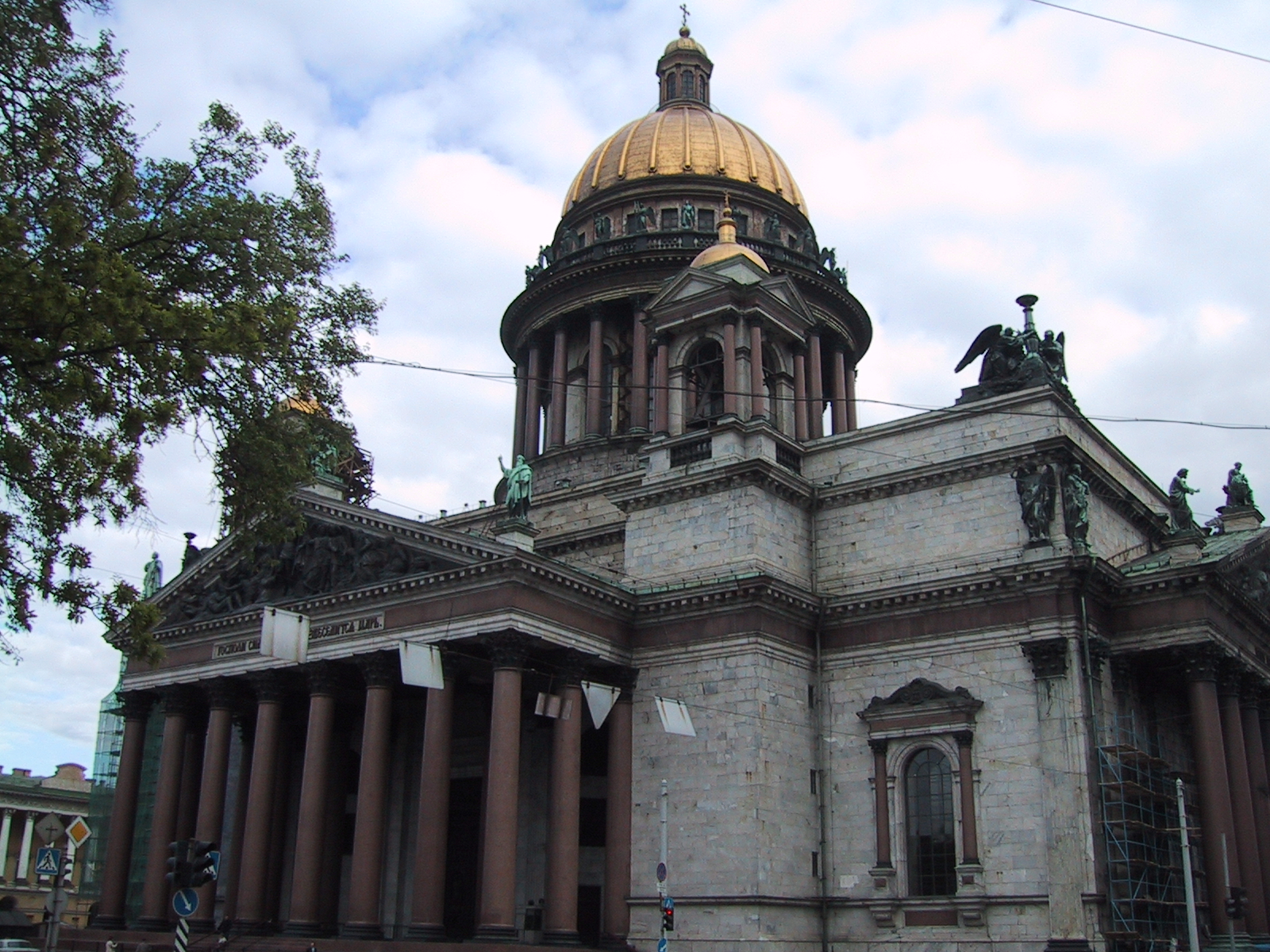 We have seen the most amazing mosiacs of the church of St Issac, once the home of the Russian Orthodox church and now a museum. The interior was originally decorated with paintings by Carlo Brullo and other great Russian masters of the day but when the paintings began to deteriorate from the damp conditions, they were reproduced with multicolored granite and marble mined from all parts of Russia. It’s a very intricate and highly skilled artform. From a distance they look like paintings. The gold dome was painted gray during World War II to avoid the bombs of Nazi war planes.
We have seen the most amazing mosiacs of the church of St Issac, once the home of the Russian Orthodox church and now a museum. The interior was originally decorated with paintings by Carlo Brullo and other great Russian masters of the day but when the paintings began to deteriorate from the damp conditions, they were reproduced with multicolored granite and marble mined from all parts of Russia. It’s a very intricate and highly skilled artform. From a distance they look like paintings. The gold dome was painted gray during World War II to avoid the bombs of Nazi war planes.
We’ve seen the beautiful bridges over the canals and the old KGB building which is still used as a police building.
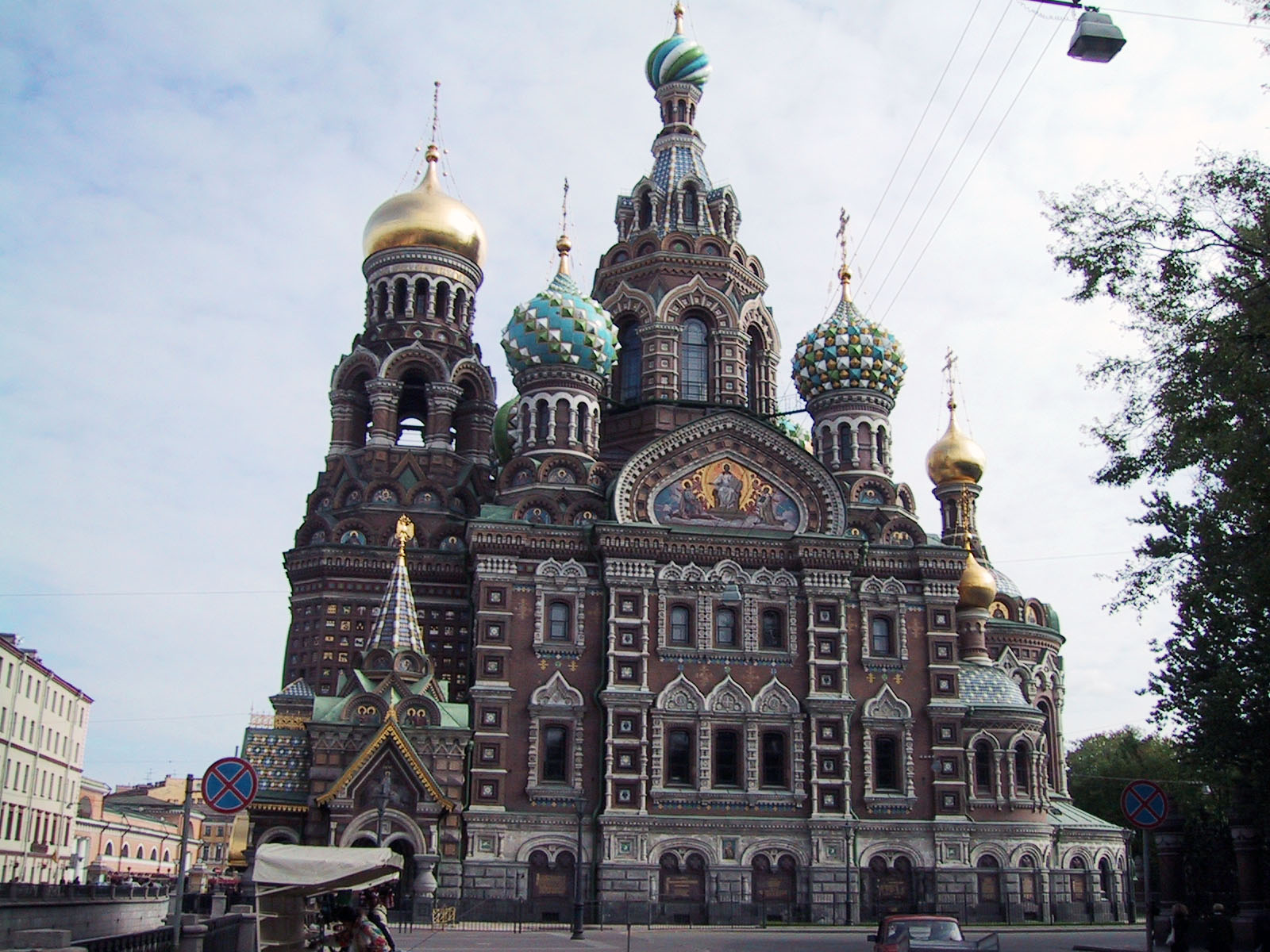 Today we walked over to The Church of the Savior on Spilt Blood, a large onion domed beauty build by Alexander III in 1907 to honor his father Alexander II who was assasinated by an anarchist on the site of the church in 1881. It was one of the largest undertakings of it’s day and every great architect and artist in Russia was involved in the construction. The walls and ceilings inside the Church are completely covered in intricately detailed mosaics. Unfortunately, ten years after the church was completed, the Russian Revolution began and the Church interior was devastated from the looting.
Today we walked over to The Church of the Savior on Spilt Blood, a large onion domed beauty build by Alexander III in 1907 to honor his father Alexander II who was assasinated by an anarchist on the site of the church in 1881. It was one of the largest undertakings of it’s day and every great architect and artist in Russia was involved in the construction. The walls and ceilings inside the Church are completely covered in intricately detailed mosaics. Unfortunately, ten years after the church was completed, the Russian Revolution began and the Church interior was devastated from the looting.
During the Nazi siege of Leningrad it was used as a warehouse for vegetables, giving it the nick -name “the Church of the Savior on Potatoes”. But thanks to common sense and tourists dollars, the Church has been almost restored to it’s original beauty. It’s become the symbol of St Petersburg.
May 12, 2001
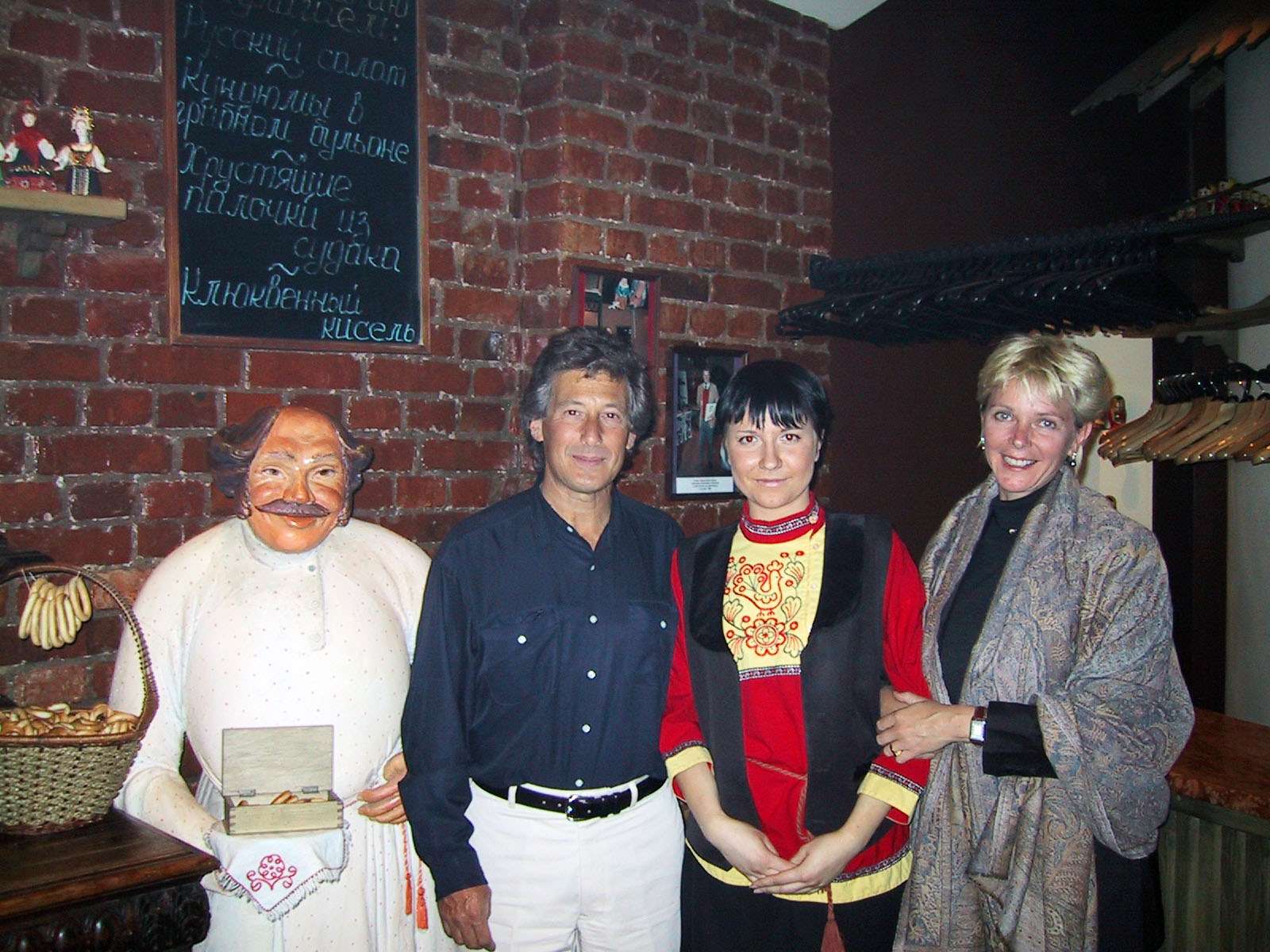 Alla recommended a great restaurant last night, a real Russian adventure. We had to hail a cab.
Alla recommended a great restaurant last night, a real Russian adventure. We had to hail a cab.
The eatery is called “Nostrovia” a very local place serving traditional russian and soviet food. There a couple of Germans there but we were the only english speakers. We dined on caviar,salted herring, borscht, meat soup, stewed veal on potatoes and rum baba. An amazing meal for less than $40 for the both of us. Good Russian home cooking…Then we had to bargin a price for the fare. Even though the meter is running, they never pay attention to the metered rate. Alla explained to us that we had to agree to the price before hand or be prepared for a big shock when we got to the restaurant.
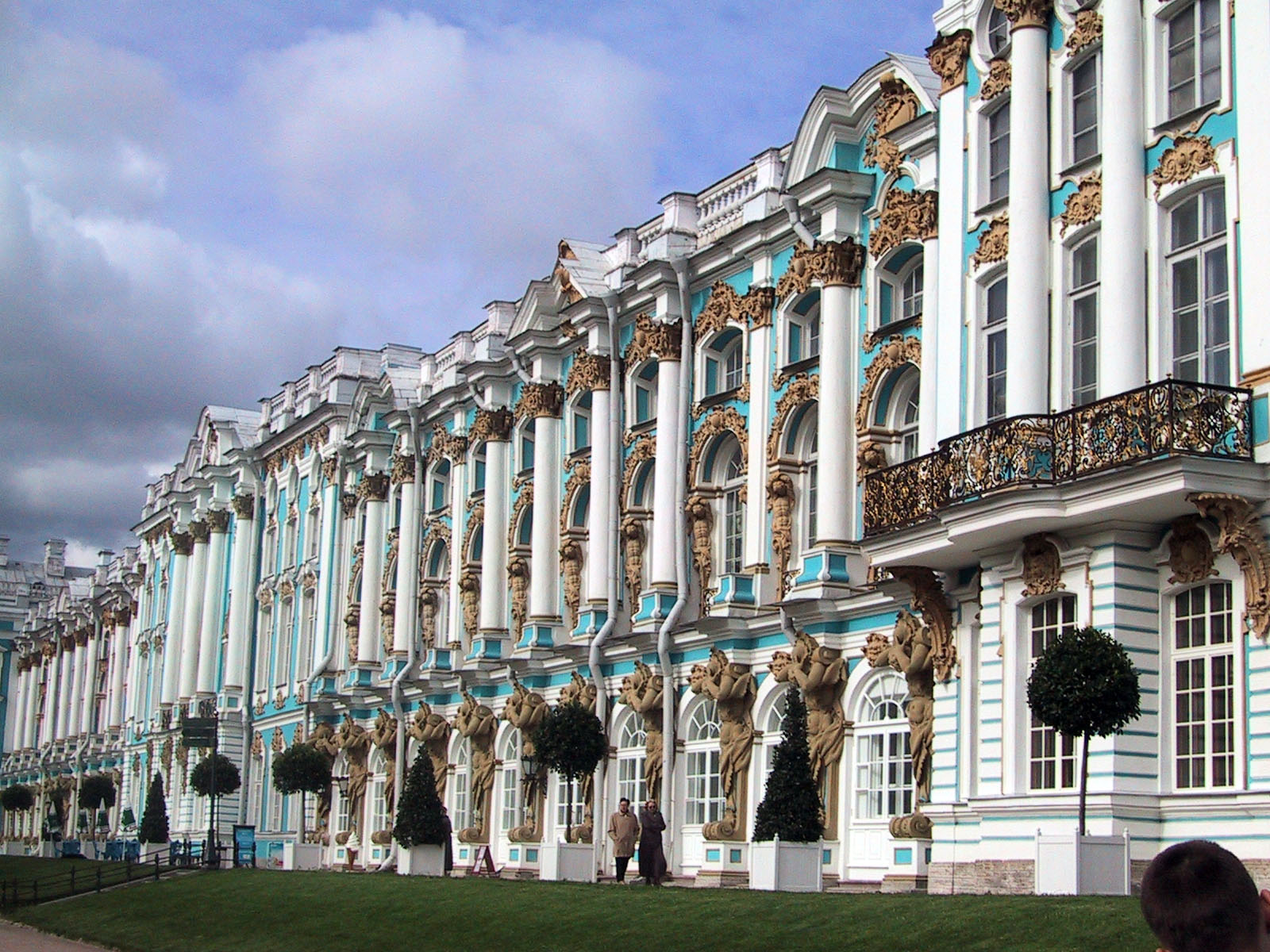
Today’s journey was to Tsarskoye Selo (Czar’s Village). First stop, teh Summer Palace of Catherine the Great. This 300 meter long palace was similar in style to the winter palace, but every room was baroque gold guilded, amazing. The Nazis had taken the Palace during the war and everything was looted and bombed, but the Russians began a restoration starting in 1949 and still continues to duplicate everything as it once was. The restoration includes the intricately laid parquet floors, the woven silks, the carved wood detail, the gold guilding, the plaster work, and amber mosiacs in the Amber room (yes, it is a room lined entirely of carved amber). Each room is more fabulous than the last.
We took a walk in the Palace Gardens and it snowed, perfect for a Russian afternoon in May.
Pavlovska is the bracelet shaped summer home of Paul I, son of Catherine II. She had the Palace built for him and his bride, Sophie Marie Dorothea Prinzessin von Württemberg. Catherine turned out to be a great artist and some of her models and sculptures and paintings still exist in this Palace. 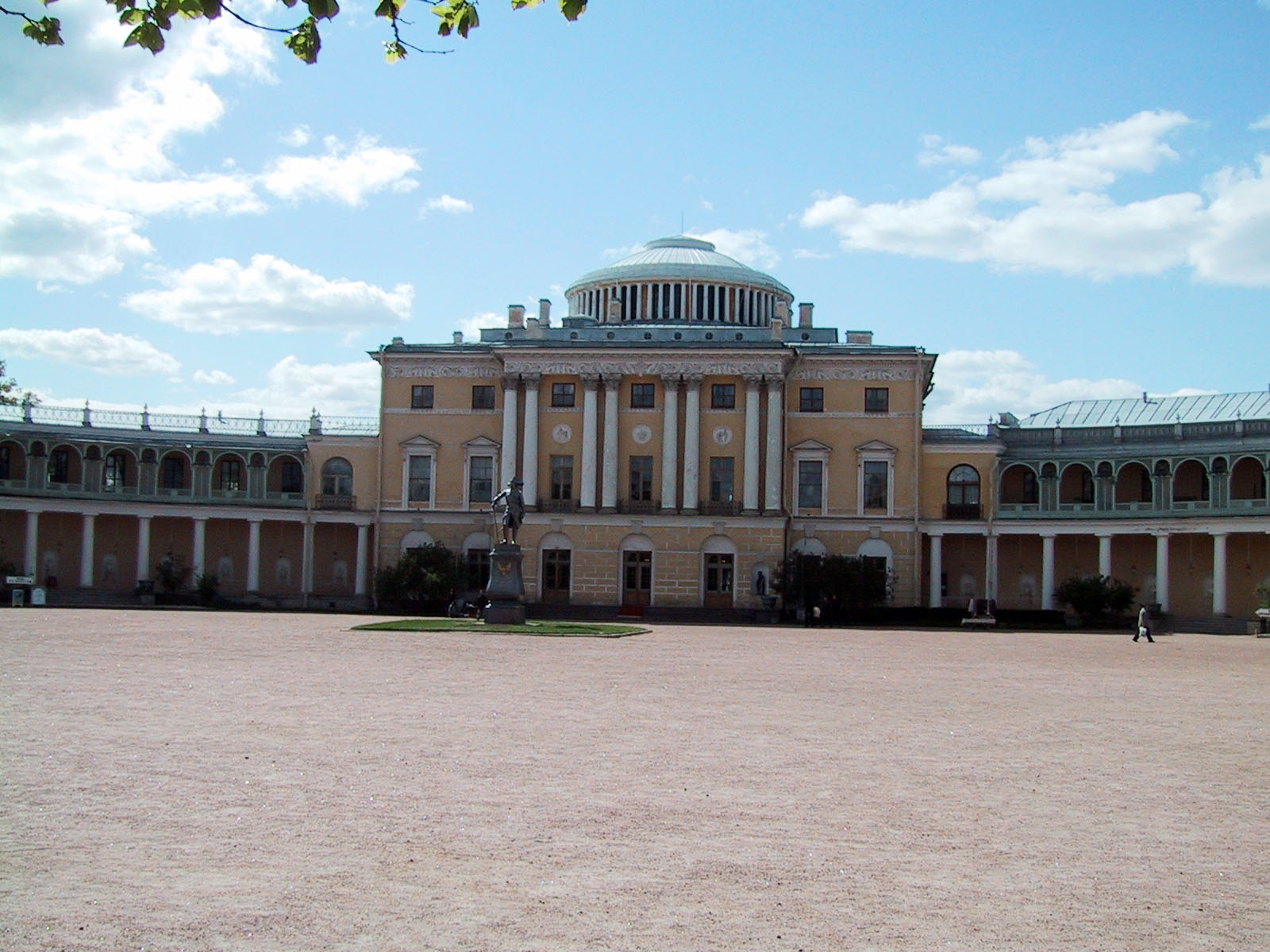
Pavlovska was also bombed out during the war and you can see before and after pictures in each of the giant rooms. As in Catherine’s Palace, the work on Pavlovska is exquisite and continues to go on. Paul didn’t last very long as Tsar, barely 5 years. He was killed by conspiritors when he was about 47 but Marie went on for quite a few more years developing many charities for the Russians. We bought a bunch of books in the book store and then purchased some russian scarves and dolls. We always seem to buy stuff we don’t need when we’re having a great time somewhere.
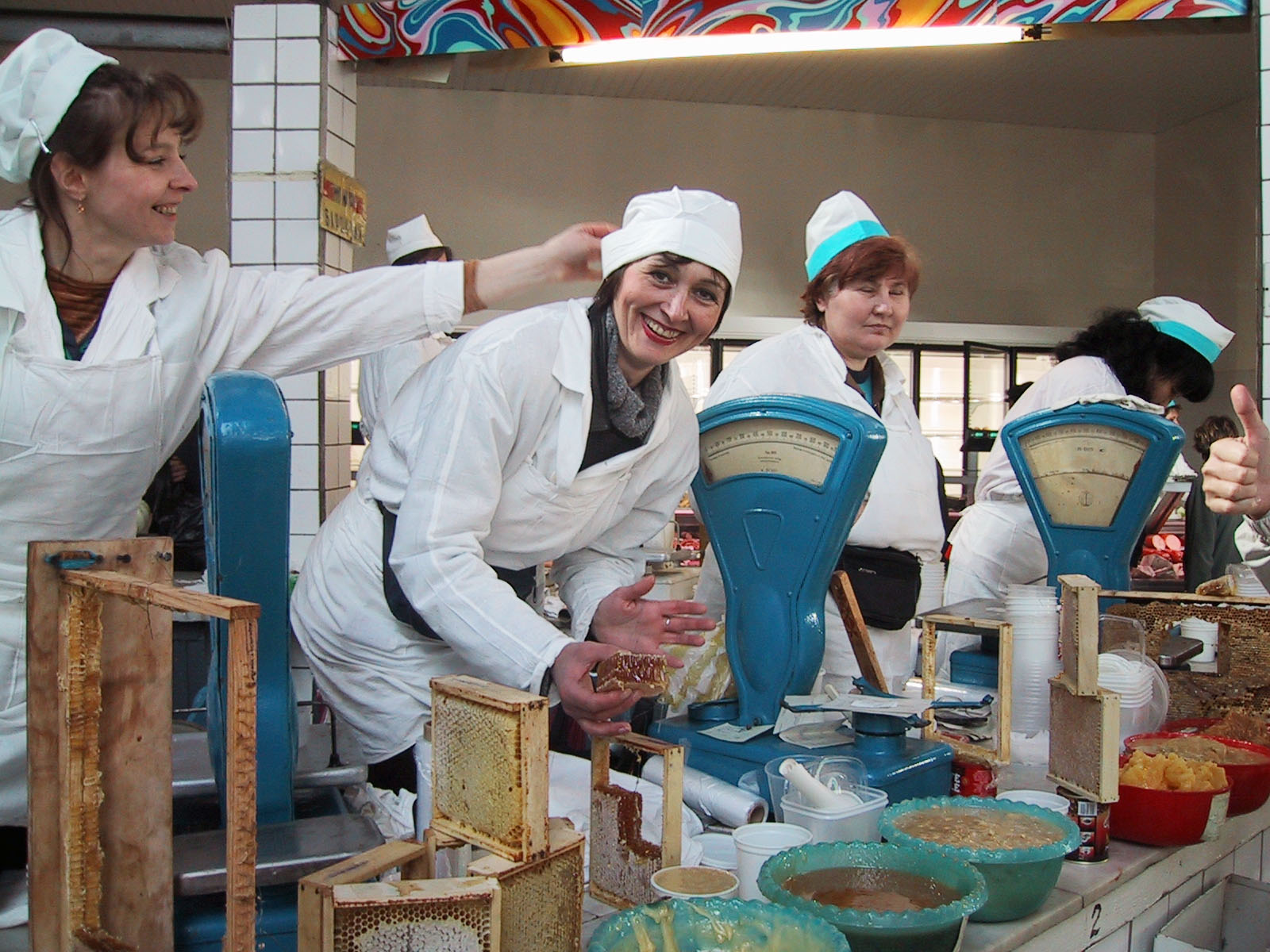 On the way home we stopped off at the local grand market with Alla. This was the most fun. Alla had set our itinerary as the basic historical program. She was very good and always stuck close to the script. But we wanted to know more about everyday life in Russia; what it was like to live under the Soviets. We finally got her to loosen up and she took us to the market.
On the way home we stopped off at the local grand market with Alla. This was the most fun. Alla had set our itinerary as the basic historical program. She was very good and always stuck close to the script. But we wanted to know more about everyday life in Russia; what it was like to live under the Soviets. We finally got her to loosen up and she took us to the market.
There were vegetables, meats, dried fruits, more kinds of smoked fish then you can imagine, the 20 meter long pickle counter, the 30 meter long honey counter with large jars of all kinds of honey, the cheese counter with soft ricotta style cheeese, clotted cream, sour cream, smoked cheese, farmer’s cheese and others we never got to try. Every booth you go to, they offer samples. It’s hard to turn them down, and they are all delicious. We bought some honey for Sasha, and for us, some smoked cheese, 2 pickles and some marinated salmon with onions. It all reminded me of my youth at the bar mitzvah table. Alla was charmed to see us so excited. “See the big women with one eye brow?” she asked. “Of course”, we responded. Every one of the women behind the market tables fir that description. “They’re all from Georgia, she smiled.”
We got back to the room, had a few glasses of wine and then went to another restaurant of Alla’s choice, the “Orient Express” on Marata 21. It was a good walk from the hotel and we got to see more of the city on foot. The restaurant was modern and trendy and the food was good; caviar, cold borcht, salyana, veal. But we were seated next to some really loud and obnoxious Canadians, which was kind of strange. We always thought of Canadians as the height of good behavior. When they finished their second bottle of wine they got even louder, screaming to each other across the able. We tried to move our seats but there wasn’t anywhere else to go. I asked the manager if he could do anything and he shrugged. And so I finally got up and asked them if they could bring the decibel level down. Big mistake on my part…They quieted down for a minute but soon started heating up. About 10 minutes later they popped. One of them started screaming at me that “all you americans are all the same, you want everyone do do what you want, you’re all fuckin assholes” It was loud and embarassing and everyone else in the restaurant, including the owners and wait staff, got real quiet. I should have kept my mouth shut. Lesson learned.
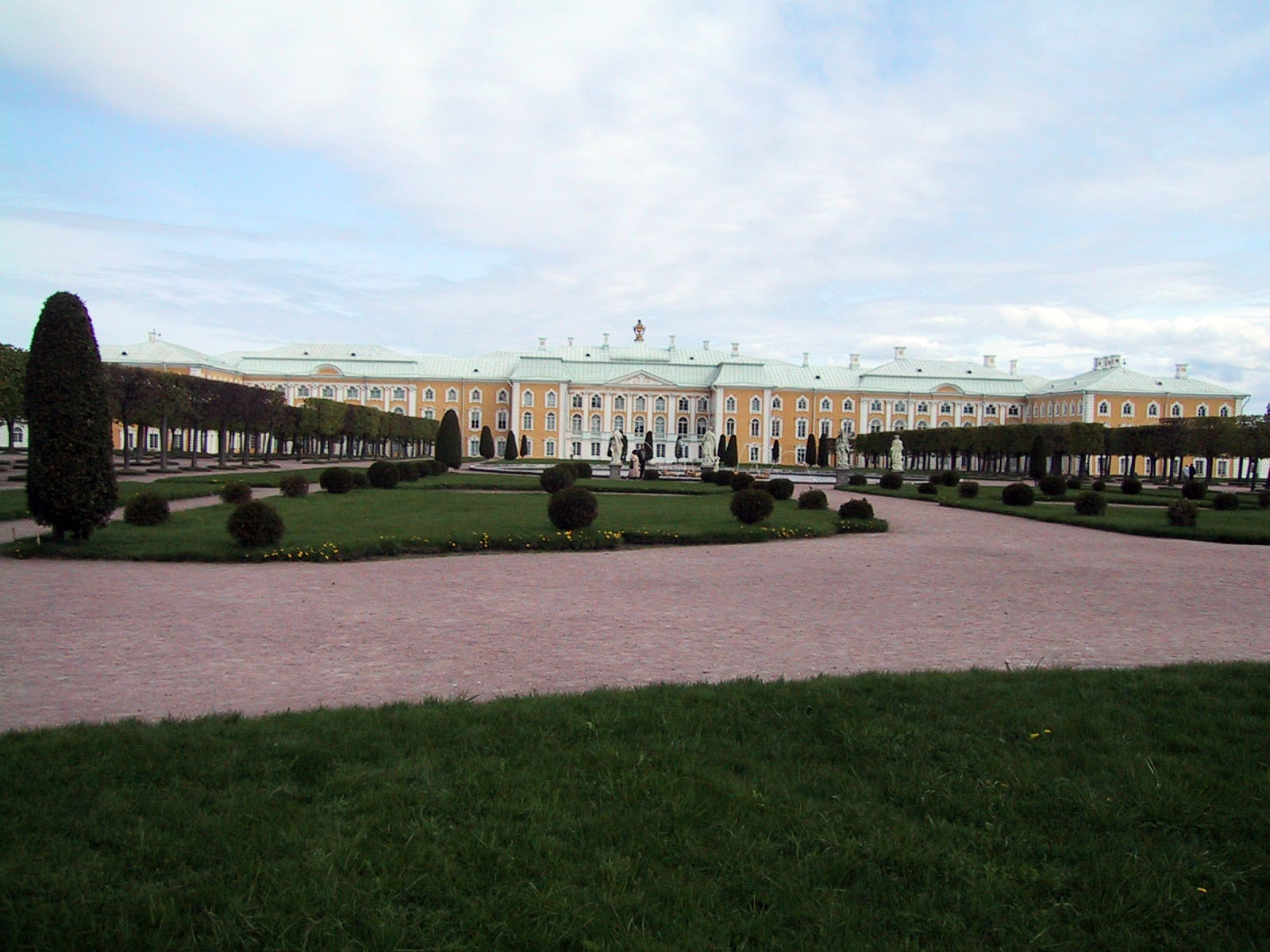 May 13, 2001
May 13, 2001
When Peter the Great built Peterhof, he wanted it to rival Versailles. We think he did a fine job. The gardens are magnificent and all of the 100 or so fountains run off of a gravity fed system flowing from a lake to the Gulf of Finland. The designers engineered enough pressure in the pipes to create a magical wonderland of water fountains, some of them shooting 40 feet into the air.
One of the fountains was built solely to entertain the children. As they played nearby, their guardian would step on a secret foot pedal and engage the fountain, soaking the children. They would run away screeching but always came back for more.

The grand entrance canal brought dignitaries from the Gulf of Finland to the front entrance. We’re standing on one of the bridges that cross the canal. Beautiful Tulip gardens and fountains are everywhere.
Alla is becoming more comfortable with us and opening up quite a bit. Today she explained that the gay population of St Petersburg is exploding. She calls gays “blues”. Allah has informed us that the cat is the last animal life form before the spirit is reincarnated into a human form. She thinks because cats have been neutered so much over the past many years, this is the reason why there are so many gay people now. An amazing theory.
Our last day included the Russian Museum housed in the Mikhailovsky Palace. Actually, the museum collection has been there since 1898. In 1998 the palace underwent a centenial renovation and it’s pretty spiffy. There are rooms of 12th century Russian Orthodox icons and great 19th century masters like Carl Buloov, Repov and others, none of which I have ever heard of before.
It was a sad farewell to Alla. She offered to have us stay at her home the next time we came to town. We hope she’ll come to visit us in San Francisco. By the way, Alla told us how she loved Broadway musicals and when we were in Edinburgh we found a video store and picked a few up for her.]
 May 14th, 2001
May 14th, 2001
Sasha made a stop at a local liquor store and came out with a box of chocolates and a bottle of Diplomat vodka, his favorite kind. Here is a gift, he said handing th goods to us. This is the vodka I told you about. It was a great gesture. On the way to the airport he decided to do some tour guiding himself. “The building” he pointed through the windshield. “Make vight vater”. White water, white water. We looked at each other. What could it be. “MilK?” Gretchen asked. “Ya”, Sasha replied. “Vight vater iz milch”. It turns out that driving is his 2nd profession. He works for Panalpina as well and he was really happy to hear I knew about the company.